S. KOREA REPORTS 93,135 CASES
입력 2022.02.17 (15:26)
수정 2022.02.17 (16:46)
읽어주기 기능은 크롬기반의
브라우저에서만 사용하실 수 있습니다.
[Anchor Lead]
Daily cases in Korea have surpassed 90-thousand for the second day, recording 93,135 as of midnight of Thursday. Since late January, daily cases have been doubling every week. The question now is when the outbreak will peak and how long this trend will continue.
[Pkg]
The nation's daily COVID-19 tally topped ten thousand for the first time on Jan. 26. In just a week the figures surpassed 20,000. Seven days later it exceeded 40,000 and then went up to 90,000 the following week. The number of cases has been doubling every week.n Authorities expect the daily tally to soar to between 130,000 and 170,000 by the end of this month. If the current trend persists, the figures could reach 200,000. The National Institute for Mathematical Sciences predicts daily COVID-19 cases could reach 360,000 by March 2.
[Soundbite] Choi Sun-hwa(National Institute for Mathematical Sciences) : "The estimate includes vaccination rates and breakthrough infections. It is believed breakthrough infections are less likely to impact others, but if this group continues to grow, the outbreak could ultimately increase. If they turn out to be lower than my estimate, the outbreak could shrink."
Many experts believe the Omicron wave could peak in early to mid March. It's still unclear if the outbreak will subside shortly after reaching the peak or if it will linger for much longer than that. In countries hit by the Omicron waves earlier, daily cases doubled every two or three days but started falling right after peaking. In South Korea, where the outbreak is growing relatively slowly, chances are high that it will last longer.
[Soundbite] Prof. Kim Woo-joo(Korea Univ. Guro Hospital) : "Despite the high vaccination rate, only 3 percent of the population or 1.5 mn people, were infected naturally. The number of cases will probably go down gradually rather than abruptly."
The next 3-4 weeks will be decisive in determining the scope and duration of the outbreak.
Daily cases in Korea have surpassed 90-thousand for the second day, recording 93,135 as of midnight of Thursday. Since late January, daily cases have been doubling every week. The question now is when the outbreak will peak and how long this trend will continue.
[Pkg]
The nation's daily COVID-19 tally topped ten thousand for the first time on Jan. 26. In just a week the figures surpassed 20,000. Seven days later it exceeded 40,000 and then went up to 90,000 the following week. The number of cases has been doubling every week.n Authorities expect the daily tally to soar to between 130,000 and 170,000 by the end of this month. If the current trend persists, the figures could reach 200,000. The National Institute for Mathematical Sciences predicts daily COVID-19 cases could reach 360,000 by March 2.
[Soundbite] Choi Sun-hwa(National Institute for Mathematical Sciences) : "The estimate includes vaccination rates and breakthrough infections. It is believed breakthrough infections are less likely to impact others, but if this group continues to grow, the outbreak could ultimately increase. If they turn out to be lower than my estimate, the outbreak could shrink."
Many experts believe the Omicron wave could peak in early to mid March. It's still unclear if the outbreak will subside shortly after reaching the peak or if it will linger for much longer than that. In countries hit by the Omicron waves earlier, daily cases doubled every two or three days but started falling right after peaking. In South Korea, where the outbreak is growing relatively slowly, chances are high that it will last longer.
[Soundbite] Prof. Kim Woo-joo(Korea Univ. Guro Hospital) : "Despite the high vaccination rate, only 3 percent of the population or 1.5 mn people, were infected naturally. The number of cases will probably go down gradually rather than abruptly."
The next 3-4 weeks will be decisive in determining the scope and duration of the outbreak.
■ 제보하기
▷ 카카오톡 : 'KBS제보' 검색, 채널 추가
▷ 전화 : 02-781-1234, 4444
▷ 이메일 : kbs1234@kbs.co.kr
▷ 유튜브, 네이버, 카카오에서도 KBS뉴스를 구독해주세요!
- S. KOREA REPORTS 93,135 CASES
-
- 입력 2022-02-17 15:26:38
- 수정2022-02-17 16:46:00

[Anchor Lead]
Daily cases in Korea have surpassed 90-thousand for the second day, recording 93,135 as of midnight of Thursday. Since late January, daily cases have been doubling every week. The question now is when the outbreak will peak and how long this trend will continue.
[Pkg]
The nation's daily COVID-19 tally topped ten thousand for the first time on Jan. 26. In just a week the figures surpassed 20,000. Seven days later it exceeded 40,000 and then went up to 90,000 the following week. The number of cases has been doubling every week.n Authorities expect the daily tally to soar to between 130,000 and 170,000 by the end of this month. If the current trend persists, the figures could reach 200,000. The National Institute for Mathematical Sciences predicts daily COVID-19 cases could reach 360,000 by March 2.
[Soundbite] Choi Sun-hwa(National Institute for Mathematical Sciences) : "The estimate includes vaccination rates and breakthrough infections. It is believed breakthrough infections are less likely to impact others, but if this group continues to grow, the outbreak could ultimately increase. If they turn out to be lower than my estimate, the outbreak could shrink."
Many experts believe the Omicron wave could peak in early to mid March. It's still unclear if the outbreak will subside shortly after reaching the peak or if it will linger for much longer than that. In countries hit by the Omicron waves earlier, daily cases doubled every two or three days but started falling right after peaking. In South Korea, where the outbreak is growing relatively slowly, chances are high that it will last longer.
[Soundbite] Prof. Kim Woo-joo(Korea Univ. Guro Hospital) : "Despite the high vaccination rate, only 3 percent of the population or 1.5 mn people, were infected naturally. The number of cases will probably go down gradually rather than abruptly."
The next 3-4 weeks will be decisive in determining the scope and duration of the outbreak.
Daily cases in Korea have surpassed 90-thousand for the second day, recording 93,135 as of midnight of Thursday. Since late January, daily cases have been doubling every week. The question now is when the outbreak will peak and how long this trend will continue.
[Pkg]
The nation's daily COVID-19 tally topped ten thousand for the first time on Jan. 26. In just a week the figures surpassed 20,000. Seven days later it exceeded 40,000 and then went up to 90,000 the following week. The number of cases has been doubling every week.n Authorities expect the daily tally to soar to between 130,000 and 170,000 by the end of this month. If the current trend persists, the figures could reach 200,000. The National Institute for Mathematical Sciences predicts daily COVID-19 cases could reach 360,000 by March 2.
[Soundbite] Choi Sun-hwa(National Institute for Mathematical Sciences) : "The estimate includes vaccination rates and breakthrough infections. It is believed breakthrough infections are less likely to impact others, but if this group continues to grow, the outbreak could ultimately increase. If they turn out to be lower than my estimate, the outbreak could shrink."
Many experts believe the Omicron wave could peak in early to mid March. It's still unclear if the outbreak will subside shortly after reaching the peak or if it will linger for much longer than that. In countries hit by the Omicron waves earlier, daily cases doubled every two or three days but started falling right after peaking. In South Korea, where the outbreak is growing relatively slowly, chances are high that it will last longer.
[Soundbite] Prof. Kim Woo-joo(Korea Univ. Guro Hospital) : "Despite the high vaccination rate, only 3 percent of the population or 1.5 mn people, were infected naturally. The number of cases will probably go down gradually rather than abruptly."
The next 3-4 weeks will be decisive in determining the scope and duration of the outbreak.
이 기사가 좋으셨다면
-
좋아요
0
-
응원해요
0
-
후속 원해요
0










![[HEADLINE]](https://news.kbs.co.kr/data/news/title_image/newsmp4/news_today/2022/02/17/10_5397527.jpeg)



![[단독] 골프연습장 아니라더니<br>…‘한남동 골프연습장’ 도면 입수](/data/news/2025/07/01/20250701_Uh8Jnu.png)


이 기사에 대한 의견을 남겨주세요.